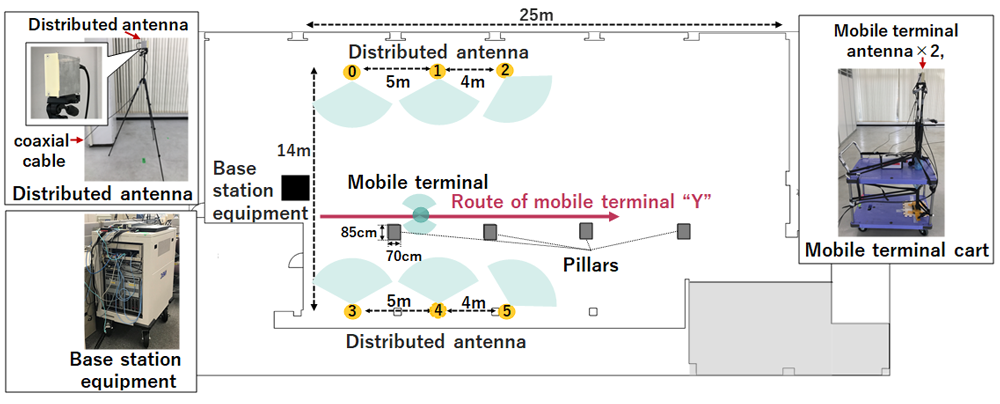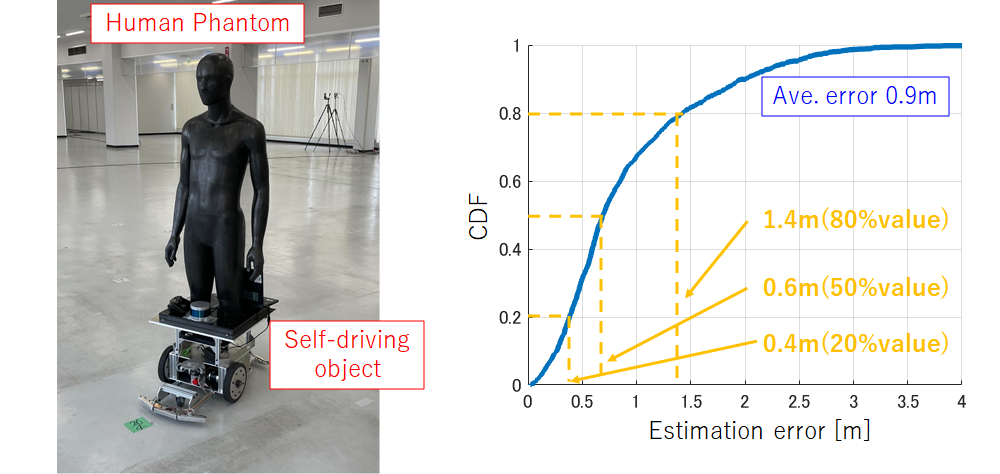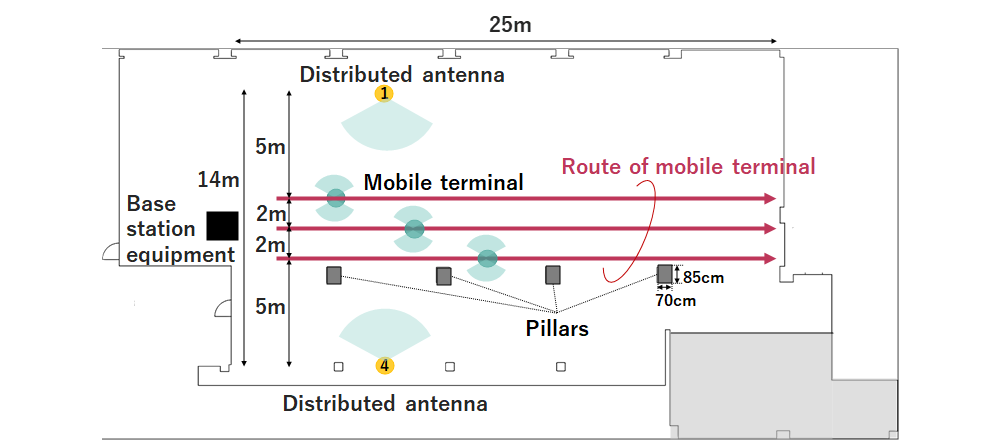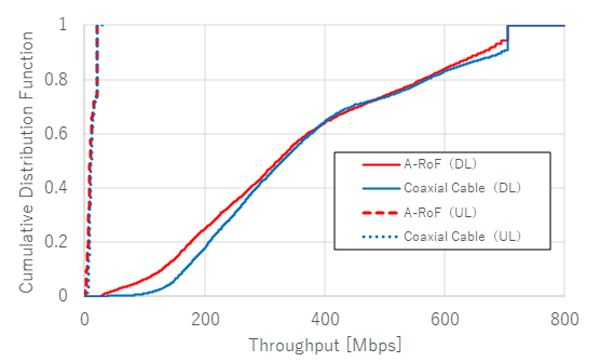Microsoft ends support for Internet Explorer on June 16, 2022.
We recommend using one of the browsers listed below.
- Microsoft Edge(Latest version)
- Mozilla Firefox(Latest version)
- Google Chrome(Latest version)
- Apple Safari(Latest version)
Please contact your browser provider for download and installation instructions.
October 31, 2022
World's first successful demonstration of distributed MIMO that continues wireless connections in the 28 GHz band by eliminating shielding issues
—Enables high-capacity communication even in severely shielded environments such as shopping malls and factories—
TOKYO, JAPAN. - October 31, 2022 - Nippon Telegraph and Telephone Corporation (Headquarters: Chiyoda-ku, Tokyo, President: Akira Shimada, hereafter "NTT"), NTT DOCOMO, INC. (Headquarters: Chiyoda-ku, Tokyo, President: Motoyuki Ii, hereafter "DOCOMO"), and NEC Corporation (Headquarters: Minato-ku, Tokyo, President and CEO: Takayuki Morita, hereafter "NEC") conducted a demonstration experiment of a technology (hereafter, this technology) characterized as distributed MIMO*1 in the 28 GHz band. This technology, for the first time in the world*2, grasps environmental information such as the wireless propagation conditions within an area and the location of mobile terminals and dynamically switches the distributed antennas of base stations according to the environment.
Experiments have shown the possibility of using high-frequency bands for stable large-capacity wireless transmission, even in environments with many obstructions such as shopping malls and factories. In addition, demonstrations of wireless sensing technology were also conducted, which enabled the position of obstacles to be detected using distributed MIMO, as well as demonstration of A-RoF (Analog Radio over Fiber)*3 transmission technology, one of the optical-wireless fusion technologies of IOWN*4 that can realize wide-area for distributed MIMO.
In the future, we will proceed with demonstration experiments in order to expand the applicable frequencies and use cases of distributed MIMO, such as demonstrations in frequency bands higher than the 28 GHz band and environments where obstacles such as the human body move constantly.
This technology will be introduced at the "NTT R&D Forum Road to IOWN 2022"*5 scheduled to be held from November 16 (Wednesday) to 18 (Friday), 2022.
1.Research Background
5G Evolution & 6G are expected to realize collection of video and sensing information in the real world through cyber-physical fusion, transmission information on body feeling as perceived by the five senses, and multi-sensory communication including the senses of mood and security, etc. In order to achieve these goals, it is essential to further increase the transmission speed and capacity of wireless communication, and the use of the millimeter wave band and sub-terahertz band, which have higher frequencies than the current 5G, is being considered for mobile communication.
In these high-frequency bands, radio wave propagation is greatly attenuated by shielding, so countermeasures against shielding are important. Distributed MIMO in the high-frequency band, in which multiple distributed antennas are controlled by one base station (hereafter referred to as "the distributed antennas") and wirelessly transmit signals from multiple directions to each active mobile terminal, is one of the most promising methods for overcoming this problem. However, the strong attenuation of the high-frequency band makes it necessary to direct the radio wave radiation of each distributed antenna in a specific direction in order to secure complete wireless coverage. This demands dynamic radio transmission control that selects and controls distributed antennas according to the environment.
Whether or not a connection between a mobile terminal and each distributed antenna can be achieved is determined by obtaining wireless quality information from each distributed antenna. In the low-frequency band where radio wave refraction is significant, even if the mobile terminal moves to a location blocked by a pole or the like, the quality of the radio wave fluctuates slowly, but in the high-frequency band the radio quality fluctuates abruptly and disconnection may occur. A key problem is that the disconnection might not be grasped by the base station until the next wireless quality information is obtained, and during that time the appropriate distributed antenna could not be selected. One method to solve this problem is to switch to the appropriate distributed antennas in advance based on the estimated position of the mobile terminal acquired by an external system such as GPS (Global Positioning System) or camera images. However, the application feasibility depends on the external system, such as mobile terminals that support the system and areas compatible with the system and a mechanism that can constantly acquire the location information. Therefore, there is a need for a technology that can select the appropriate distributed antennas to avoid disconnection due to obstacles without relying on information from an external system.
Therefore, NTT, DOCOMO, and NEC have been studying this technology in their demonstration experiment cooperation*6 for technology of distributed MIMO using high-frequency band announced on June 6th (Monday), 2022 and a demonstration experiment was conducted from June 6th (Monday) to September 29th (Thursday), 2022.
2.Technology Overview and Experimental Results
2-1. Development of dynamic distributed antenna selection technology for distributed MIMO systems that can perceive the environment
- Technology Overview -
To solve the above problem, NEC developed a technology that utilizes distributed antennas to allow the distributed MIMO system itself to predict the location of mobile terminals and select the appropriate distributed antenna. Specifically, the radio quality of each distributed antenna is continuously measured at each location in the area, and the optimum distributed antenna is discerned in advance. During operation, the distributed MIMO system itself continuously monitors the radio quality of mobile terminals at each distributed antenna and estimates the location of mobile terminals by applying machine learning. In addition, it predicts future movement from past estimated positions of mobile terminals, and predicts mobile terminal positions and optimal distributed antennas until the next acquisition of radio quality information. As a result, even if movement of the mobile terminals causes the transmission performance to drop sharply or disconnection to occur due to blocking, the distributed antennas elucidated from the current radio quality information will allow radio communication to continue.
- Experimental Results -
A demonstration experiment of this technology was conducted in a laboratory (Figure 1-1). The area was 25 x 15 x 3.5m, and there were four pillars that acted as obstacles within the testing area. The experimental base station equipment and antennas that were used complied with the physical-layer specifications of the 5G NR 28 GHz band, and used OFDM (Orthogonal Frequency Division Multiplexing)*7 with a frequency band of 28 GHz, a signal bandwidth of 100 MHz, and a subcarrier spacing of 60 kHz. In addition, coaxial cables (20m) connected the base station equipment to six distributed antennas. A total of six distributed antennas were installed at positions #0 to #5, and a mobile terminal was moved on a cart along route Y in the figure to obtain radio quality information for each distributed antenna and evaluate transmission performance.
Figure 1-2 shows the relative reception strength characteristics when using this technology. For example, when the radio quality information acquisition interval was 20ms and the mobile terminal was moving at a bicycle speed (15km/h), the conventional method, which selects distributed antennas based on radio quality, allowed the received signal strength to be decreased by an average of 13dB at locations blocked by pillars. On the other hand, when distributed antennas were selected based on movement prediction using this technology, the received signal strength at the same location was increased by an average of 8dB compared to the conventional method, to a loss of about 5dB. As a result, NEC confirmed that it is possible to avoid instantaneous disconnections, which is a concern in high-frequency distributed MIMO. Based on these results, it is expected that high-speed, large-capacity communications using high-frequency bands can be stably realized even when terminals are moving.
 Figure 1-1. Overview of the experimental area and experimental system
Figure 1-1. Overview of the experimental area and experimental system
 Figure 1-2. Experimental results (relative reception strength characteristics between the conventional method and utilization of this technology)
Figure 1-2. Experimental results (relative reception strength characteristics between the conventional method and utilization of this technology)
2-2. Wireless Sensing Technology
- Technology Overview -
For realizing distributed antenna selection, it is important to understand the position of shielding objects that do not have communication devices in addition to the position of mobile terminals. Fixed shielding objects can be identified through preliminary survey of the wireless environment, but it is difficult to identify moving shield objects such as the human body.
Therefore, NTT and DOCOMO proposed a wireless sensing technology to estimate the position of shielding objects from the wireless information that can be obtained from within the system. Specifically, time-series features based on correlation information between distributed antennas is extracted from periodically acquired channel state information (CSI)*8, and machine learning based on prior data used to estimate the position of shielding objects.
- Experimental Results -
Using the same experimental environment and distributed antenna condition as in the verification described in section 2-1, we conducted a validation experiment on this technology by moving a human phantom (mannequin) within the area as if it were a shielding object. We trained the time-series features extracted from the CSI between the mobile terminal and each distributed antenna, and estimated the position of the human phantom from the CSI acquired again during operation. This is the first demonstration in the world of the distributed MIMO system estimating a shielding object without a mobile terminal in the high-frequency band*2. Figure 2 shows an overview of the human phantom used in the experiment and the results of position estimation error. The median estimation error in the human phantom position was approximately 0.6 m, and the average error was approximately 0.9 m. This confirms the possibility that distributed MIMO itself can determine the position of shielding objects. This technology is expected to be used not only for acquiring environmental information that supports MIMO transmission in high-frequency bands, but also for sensing services such as object detection.
 Figure 2. Human phantom and position estimation error
Figure 2. Human phantom and position estimation error
2-3. A-RoF transmission technology
- Technology Overview -
When coaxial cable is used to connect the base station equipment to the distributed antennas, the installation range is limited because the transmission loss of the coaxial cable is as high as several dB per 10m. One alternative is A-RoF (Analog-Radio over Fiber), which transmits an IF (Intermediate Frequency) signal*9 from the base station equipment as an analog signal to each distributed antenna over an optical line. A-RoF has a low transmission loss of no more than 0.5 dB per kilometer, so the distributed antennas can be installed over a wide area. In addition, it is thinner and easier to bend than coaxial cables, so it is flexible in cable laying. However, in order for distributed MIMO to support a TDD system*10 like 5G, local signals for frequency synchronization must be passed to the distributed antennas along with TDD control signals that notify transmission timing of the downlink and uplink from base station equipment to each distributed antenna along with the data signals.
Therefore, NTT and DOCOMO developed subcarrier multiplex transmission technology that transmits the local signals, the TDD control signals, and the data signals over single-mode fiber using only one single optical wavelength.
- Experimental Results -
We conducted a demonstration experiment of this technology using the same laboratory and distributed antenna as the verification in section 2-1. The overview of the experimental system is shown in Figure 3-1. The base station equipment was connected to two distributed antennas via coaxial cable or A-RoF, and the A-RoF length was set to 20m, the same as the coaxial cable. We simultaneously measured the downlink and uplink throughputs using the TDD method. This is the world's first demonstration of downlink-and-uplink two-way wireless transmission across A-RoF to a distributed antenna system for high-frequency band transmission*2. The experimental results, shown in Figure 3-2 confirmed that A-RoF offers almost the same throughput performance as coaxial cable. Even if the cable length of A-RoF is extended from 20m (this experiment) to 100m to 1,000m, the transmission loss is 0.5dB or less, and it is expected that this throughput performance can be maintained as it is. Therefore, by using A-RoF, the distributed MIMO in the high-frequency band can be applied to not only medium-scale indoor environments such as offices and stores, but also to large-scale indoor environments such as shopping malls and factories, and stable large-capacity wireless transmission can be provided even in these environments.
 Figure 3-1. Experimental system for A-RoF transmission technology
Figure 3-1. Experimental system for A-RoF transmission technology
 Figure 3-2. Experimental results (Throughput performances on downlink and uplink)
Figure 3-2. Experimental results (Throughput performances on downlink and uplink)
3.The next Step
In the future, we will proceed with verifications in frequency bands higher than the 28 GHz band, in an environment where obstacles such as the human body are moving, and under conditions where mobile terminals density is high. In addition, we will study advanced technology for automatic recognition of mobile terminal positions and surrounding obstacles using wireless sensing and verification of distributed antenna deployment technology using A-RoF for distributed MIMO in a high-frequency band.
*1:Distributed MIMO (Multi-Input Multi-Output)
A technology that controls multiple antennas from a single base station within an area and realizes MIMO transmission between these distributed antennas and mobile terminals within the area.
*2:As of October 31, 2022, according to NTT research
*3:A-RoF (Analog Radio over Fiber)
Technology for transmitting wireless signals as analog signals over optical lines.
*4: IOWN (Innovative Optical and Wireless Network),
Concept of next-generation communication infrastructure being promoted by the IOWN Global Forum. (https://iowngf.org/)
*5:NTT R&D Forum Road to IOWN 2022 URL: https://www.rd.ntt/e/forum/
*6:https://group.ntt/en/newsrelease/2022/06/06/220606a.html
*7:OFDM method (Orthogonal Frequency Division Multiplexing)
Orthogonal frequency multiplexing transmission.
*8:CSI (Channel State Information)
Radio propagation channel response between transmitting and receiving antennas. The 5G OFDM scheme has a mechanism that enables estimation for each frequency resource block.
*9:IF (Intermediate Frequency) signal
Intermediate frequency band. When performing frequency conversion processing between the baseband band and the radio frequency band, it is often the case that the frequency is first converted to an intermediate frequency band to ease implementation concerns.
*10:TDD method (Time Division Duplex)
A method in which downstream transmission and upstream transmission are performed in a time division manner.
About NTT
NTT believes in resolving social issues through our business operations by applying technology for good. We help clients accelerate growth and innovate for current and new business models. Our services include digital business consulting, technology and managed services for cybersecurity, applications, workplace, cloud, data center and networks all supported by our deep industry expertise and innovation. As a top 5 global technology and business solutions provider, our diverse teams operate in 80+ countries and regions and deliver services to over 190 of them. We serve over 80% of Fortune Global 100 companies and thousands of other clients and communities around the world. For more information on NTT, visit www.global.ntt/.
About NTT DOCOMO
NTT DOCOMO, Japan's leading mobile operator with over 85 million subscriptions, is one of the world's foremost contributors to 3G, 4G and 5G mobile network technologies. Beyond core communications services, DOCOMO is challenging new frontiers in collaboration with a growing number of entities ("+d" partners), creating exciting and convenient value-added services that change the way people live and work. Under a medium-term plan toward 2020 and beyond, DOCOMO is pioneering a leading-edge 5G network to facilitate innovative services that will amaze and inspire customers beyond their expectations.
www.docomo.ne.jp/english.
About NEC
NEC Corporation has established itself as a leader in the integration of IT and network technologies while promoting the brand statement of "Orchestrating a brighter world." NEC enables businesses and communities to adapt to rapid changes taking place in both society and the market as it provides for the social values of safety, security, fairness and efficiency to promote a more sustainable world where everyone has the chance to reach their full potential. For more information, visit NEC at https://www.nec.com.
Media Contact
NTT Information Network Laboratory Group
Planning Department, Public Relations Section
E-mail: nttrd-pr@ml.ntt.com
NTT DOCOMO, INC.
Brand Communication Department
E-mail: global_pr@nttdocomo.com
Website: www.docomo.ne.jp/english
NEC Corporation
Corporate Communications Department
E-mail: press@news.jp.nec.com
Information is current as of the date of issue of the individual press release.
Please be advised that information may be outdated after that point.
NTT STORY
WEB media that thinks about the future with NTT










